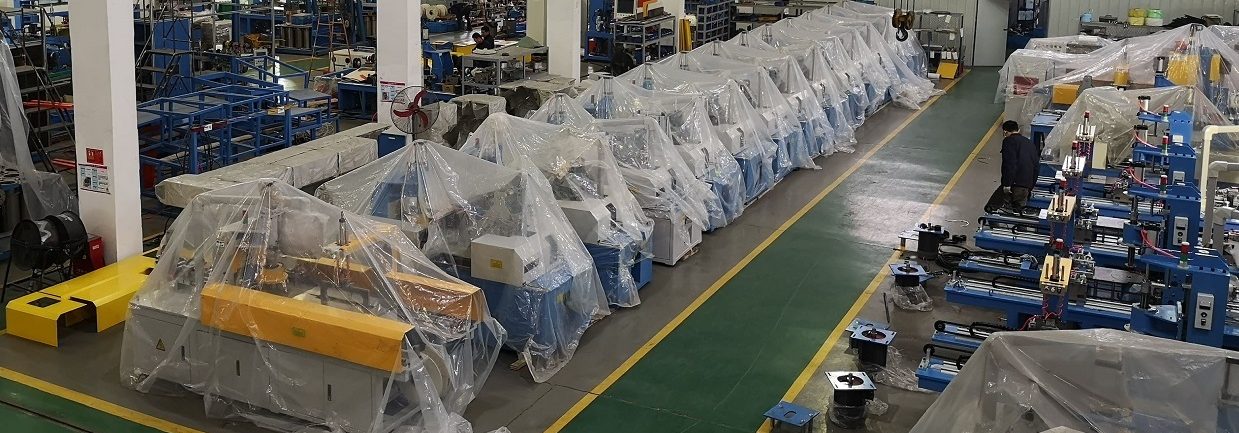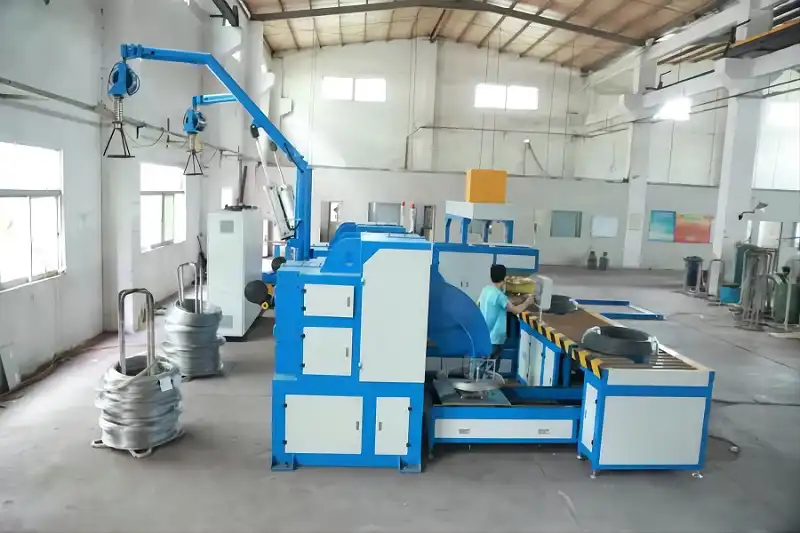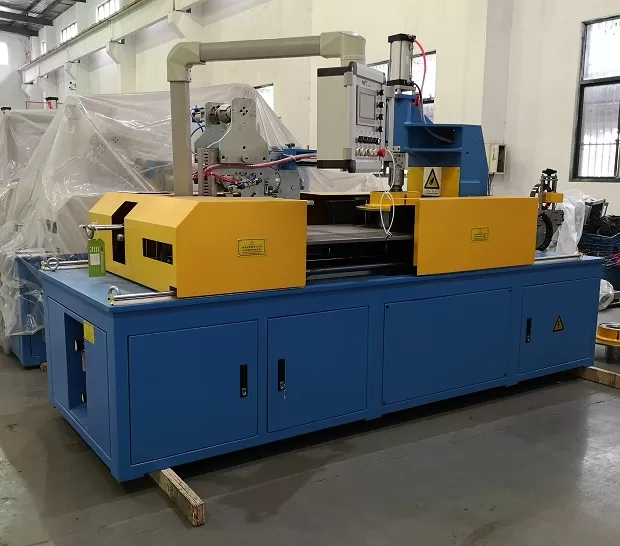As a factory manager, you know that an unexpected machine breakdown is more than just an inconvenience. It’s a full-stop on your entire production line. Your steel wire strapping machine is a critical workhorse, but when it goes down, everything grinds to a halt. You face delayed shipments, rising labor costs for idle workers, and immense pressure to get things moving again. You might already be following a strict maintenance schedule, but parts still fail unexpectedly, leaving you to wonder if you're truly in control or just waiting for the next disaster.
Predictive maintenance enhances steel wire strapping machine performance by using real-time data from sensors to monitor the machine's health. This approach allows you to forecast potential failures before they occur. Instead of reacting to breakdowns or replacing parts on a fixed schedule, you can perform targeted maintenance exactly when it's needed, maximizing uptime, reducing costs, and boosting overall operational efficiency.

This isn't just about adding new technology. It's about shifting your entire maintenance philosophy from reactive to proactive. I've walked factory floors for over 20 years, first as an engineer and later as the owner of my own packing machine factory. I’ve seen firsthand how this shift can transform an operation. Let’s break down how you can apply this powerful strategy to one of the most critical points in your production line.
What is Predictive Maintenance and How is it Different from Preventive Maintenance?
You likely have a preventive maintenance plan in place. Your team services the strapping machine every 500 hours or replaces certain parts every six months. But you've probably noticed it's not a perfect system. Sometimes a part you just replaced fails, or a sudden breakdown occurs right before a scheduled check-up. This can be incredibly frustrating and makes you feel like you're always one step behind.
Predictive maintenance (PdM) is different because it relies on the actual condition of your equipment to tell you when to perform maintenance. In contrast, preventive maintenance (PM) is based on a predetermined schedule. Essentially, PdM is a proactive, data-driven strategy, while PM is a scheduled, time-based routine. PdM aims to fix a problem right before it happens, saving you time and money.

Dive Deeper: Choosing the Right Maintenance Philosophy
Understanding the differences between maintenance strategies is crucial for a manager like you, who needs to justify every decision with clear benefits. Let's look at the three main types of maintenance. I find that seeing them side-by-side makes the choice much clearer.
Three Core Maintenance Strategies
| Strategy | Trigger for Action | Core Philosophy | Pros | Cons |
|---|---|---|---|---|
| Reactive Maintenance | Equipment Failure | "If it isn't broken, don't fix it." | Lowest initial cost, no planning needed. | High downtime, expensive emergency repairs, safety risks, production chaos. |
| Preventive Maintenance (PM) | Time or Usage | "Fix it before it breaks, on a schedule." | Reduces unexpected failures, better planning. | Can be wasteful (replacing good parts), doesn't prevent all failures, still incurs downtime for service. |
| Predictive Maintenance (PdM) | Real-time Condition Data | "Use data to fix it just in time." | Minimizes downtime, lowers parts/labor cost, increases equipment life, improves safety. | Higher initial investment (sensors, software), requires new skills. |
When I first started my factory, we relied heavily on preventive maintenance. It felt like the responsible thing to do. We changed bearings, belts, and cutters on a strict calendar. But I quickly learned a hard lesson. One of our main strapping heads failed catastrophically just two weeks after a full service. The scheduled maintenance hadn't caught the underlying issue—a slight misalignment causing excessive vibration. The resulting downtime cost us a significant order.
That incident was a wake-up call. We were performing maintenance but weren't truly listening to the machine. Preventive maintenance assumes that all parts wear out at the same rate, which is simply not true in a high-intensity environment. Factors like material variations, operator habits, and ambient temperature all affect a machine's health. Predictive maintenance addresses this by using sensors to monitor these subtle changes. It transforms maintenance from a routine task into an intelligent response to the machine's actual needs.
What are the Key Components and Sensors Needed for Predictive Maintenance?
Thinking about installing a network of sensors on your factory floor might sound complex and overwhelming. As a manager, you're focused on operations, not on becoming an IT expert. You might worry about adding another layer of technology that could fail or require specialized training your team doesn't have.
The good news is that the core components for predictive maintenance are robust, proven, and more straightforward than you might think. For a steel wire strapping machine, you primarily need sensors to monitor vibration, heat, and sound. These sensors act as the eyes and ears of your maintenance team, collecting vital data that software then translates into actionable insights about the machine's health.

Dive Deeper: The Tools That Make Predictive Maintenance Possible
Let's demystify the technology. These are not fragile lab instruments; they are industrial-grade tools designed for harsh environments like yours. I've helped clients integrate these systems, and the focus is always on simplicity and reliability.
Key Sensor Types for Your Strapping Machine
-
Vibration Sensors: These are perhaps the most important tool for rotating equipment. They are small accelerometers that you attach to critical points on the machine, like motor housings or bearing blocks. They can detect tiny changes in vibration that signal developing problems long before they are visible or audible to a human.
- What they find: Worn-out bearings, shaft misalignment, unbalanced components, or loose bolts. A healthy machine has a consistent vibration "signature." When that signature changes, it’s an early warning that something is wrong.
-
Thermal Imagers (Infrared Cameras): Overheating is a classic sign of trouble in both mechanical and electrical systems. A handheld thermal camera or a fixed thermal sensor can instantly spot hot spots.
- What they find: Failing bearings generating excess friction, overloaded motors, or poor electrical connections in a control panel. I remember a client who used a thermal camera during a routine inspection and found a connection in their main electrical cabinet was glowing red hot. A simple tightening of a screw prevented a potential fire and a plant-wide shutdown.
-
Acoustic Sensors: Your experienced operators can often "hear" when a machine isn't running right. Acoustic sensors formalize this by listening for specific sound frequencies.
- What they find: High-frequency sounds that indicate lubrication issues, or specific rumbles from worn gears or slipping belts.
The Brain of the System: Software
Sensors collect the data, but software makes sense of it. This data is fed into a Computerized Maintenance Management System (CMMS) or a dedicated PdM platform. You don't need to be a data scientist to use it. The software is designed to do the heavy lifting. It establishes a baseline of normal operation and then sends you a simple alert when readings deviate from that baseline. For example, you might get a text or email saying, "Vibration on strapping head motor #3 has increased by 15%. Recommend inspection at next scheduled stop." This allows you to plan your work instead of reacting to a crisis.
How Can You Implement a Predictive Maintenance Strategy for Your Strapping Machine?
You see the logic behind predictive maintenance, but the idea of implementing a new system can feel daunting. Your factory is already running at full tilt, and you can't afford major disruptions. You might be asking, "Where do I even begin? How do I do this without creating more problems than I solve?"
The key is to start small and be systematic. You don't need to overhaul your entire maintenance department overnight. The best approach is to implement predictive maintenance as a pilot program on one or two of your most critical steel wire strapping machines. This allows you to learn the process, demonstrate its value, and build confidence before scaling it across your plant.

Dive Deeper: A Step-by-Step Guide to Implementation
I've guided many factory managers through this process, and a structured, step-by-step approach always works best. It breaks a big project down into manageable tasks and ensures you get tangible results quickly.
Step 1: Identify Critical Failure Points
Before you buy a single sensor, sit down with your most experienced operators and maintenance staff. Ask them: "When this strapping machine fails, what is usually the cause?" They know the machine's personality. They will likely point to specific components.
- Common culprits: The strapping head (sealing/cutting mechanism), the tensioning motor, main drive bearings, or the conveyor system that positions the coil.
- Your goal: Create a short list of the 3-5 most common and most disruptive failure points. This is where you will focus your initial efforts.
Step 2: Start Your Pilot Program
Choose one strapping machine for your pilot. Pick one that is essential to your operations, so the benefits of improved reliability will be immediately obvious.
- Install basic sensors: Based on your list from Step 1, install the appropriate sensors. For a strapping head and motor, vibration and temperature sensors are a great starting point.
- Keep it simple: The goal here is not to capture every possible piece of data. It is to capture actionable data on your most critical components.
Step 3: Establish a Baseline
Once the sensors are installed, let the machine run normally for a week or two. The software will collect data during this period to learn the machine's "healthy signature."
- What is normal?: This baseline captures the normal levels of vibration, temperature, and sound during a typical production cycle.
- Why it's important: Without a baseline, you have no way of knowing if a reading is abnormal. This step is crucial for avoiding false alarms.
Step 4: Set Alert Thresholds and Train Your Team
With a baseline established, you can now set your alert thresholds. The software will help with this, often suggesting thresholds based on industry standards.
- Example: You might set a "yellow alert" if vibration increases by 15%, triggering an inspection. A "red alert" at a 30% increase might trigger an immediate planned shutdown.
- Empower your team: This is the most important part. Train your maintenance team not just to fix things, but to interpret these alerts. Their job shifts from performing routine tasks to becoming equipment health analysts. They are no longer just mechanics; they are problem-solvers who can prevent failures. This change can dramatically improve morale and engagement.
What are the Real-World Benefits and ROI of Predictive Maintenance for a Factory Manager?
As a practical manager, you're rightfully focused on the bottom line. New technology is interesting, but you need to know if it will deliver a clear return on investment (ROI). You're asking, "Will this actually reduce my costs and increase my output, or is it just an expensive project?" You need to see tangible benefits that justify the initial cost.
The primary benefit of predictive maintenance is a significant reduction in unplanned downtime. But the financial impact goes much deeper. It includes lower maintenance labor costs, reduced spending on spare parts, longer equipment life, and a safer work environment for your employees. The ROI is not just about preventing one big breakdown; it's about dozens of small, continuous improvements that boost your factory's overall profitability.
Dive Deeper: Calculating the True Value
Let's move away from theory and talk about the real numbers. Calculating the ROI for a PdM system is straightforward if you know what to measure. I always advise clients like you to look at both the costs and the savings.
The Investment (Costs)
First, be realistic about the upfront and ongoing costs.
- Hardware: Sensors (vibration, thermal, etc.).
- Software: The license or subscription for the CMMS or PdM platform.
- Installation & Training: The time and cost to install the hardware and train your team to use the new system effectively.
The Return (Savings)
This is where the true power of PdM becomes clear. The savings come from multiple areas.
| Savings Category | How to Calculate It | My Experience with Clients |
|---|---|---|
| Reduced Downtime | (Hours of Unplanned Downtime Avoided) x (Cost per Hour of Downtime) | This is the biggest win. A client in the steel industry calculated their line's downtime cost at over $5,000 per hour. Preventing just 10 hours of downtime a year saved them $50,000. |
| Lower Repair Costs | (Cost of Emergency Repair) - (Cost of Planned Repair) | An emergency repair often involves overtime pay, rush shipping for parts, and sometimes external contractors. A planned repair is almost always 30-50% cheaper. |
| Optimized Parts Inventory | (Value of Unnecessary Parts) - (Value of Needed Parts) | With PM, you stock parts "just in case." With PdM, you only order parts when the data tells you they're needed. This frees up cash and reduces warehouse space. |
| Increased Equipment Life | (Extended Lifespan in Years) x (Annualized Cost of a New Machine) | By fixing small issues before they cause major damage, you can often extend the life of a $100,000+ strapping machine by several years. |
| Improved Safety | (Reduced Insurance Premiums) + (Avoided Costs of an Injury) | Catastrophic failures are a major cause of workplace injuries. A safer plant is a more productive and less costly plant. This benefit is hard to quantify but incredibly valuable. |
I once worked with a factory manager in a situation very similar to yours. He was skeptical but agreed to a pilot program on his most problematic strapping line. After six months, the data was undeniable. He had avoided two major potential breakdowns that the system flagged early. His calculations showed a 20% reduction in maintenance costs for that line and, more importantly, a significant boost in its overall throughput because it was simply online more often. That pilot program paid for itself in less than a year.
My Insights!!!!!!!!!!!!
I’ve spent my life around these machines. I started on the factory floor, learned every bolt and wire, and eventually built my own company, SHJLPACK. I achieved financial independence because I learned how to make these machines run efficiently and reliably. Now, my mission is to share what I've learned to help others succeed.
When I talk to managers like you, Michael, I hear the same concerns I had. You're worried about efficiency, safety, and finding partners you can trust. You’ve been burned by suppliers who sold you a machine and then disappeared. That is why I believe so strongly in this topic. Predictive maintenance is not about the technology itself. It’s about a new kind of partnership between you and your equipment supplier.
A supplier who just sells you a strapping machine is a vendor. A supplier who helps you implement a predictive maintenance program—who teaches you how to listen to your machine and understand the data—is a true partner. This is the core of our philosophy at SHJLPACK: to provide a "TOTAL SOLUTION FOR WRAPPING MACHINE." The solution isn't just the steel and motors; it's the knowledge and support that make you successful.
Predictive maintenance directly addresses your biggest challenges:
- Efficiency Bottlenecks: It tackles the root cause of downtime, turning your end-of-line packaging from a bottleneck into a smooth, reliable process.
- Safety Hazards: By preventing sudden, catastrophic failures, you eliminate one of the highest-risk situations for your workers. You move from reacting to accidents to actively preventing them.
- Trust: When a supplier invests time in helping you set up a system like this, it builds a foundation of trust. It shows they are committed to your long-term success, not just a short-term sale.
For me, this is personal. The packing machine industry has given me everything. Now, I want to give back by sharing the expertise that helped me and my clients grow. Investing in a smart maintenance strategy is one of the most powerful decisions a factory manager can make. It’s an investment in control, in safety, and in the future profitability of your entire operation.
Conclusion
Embracing predictive maintenance transforms your approach from reactive to proactive. It’s a powerful strategy to boost machine reliability, significantly cut operational costs, and secure a lasting competitive advantage.





